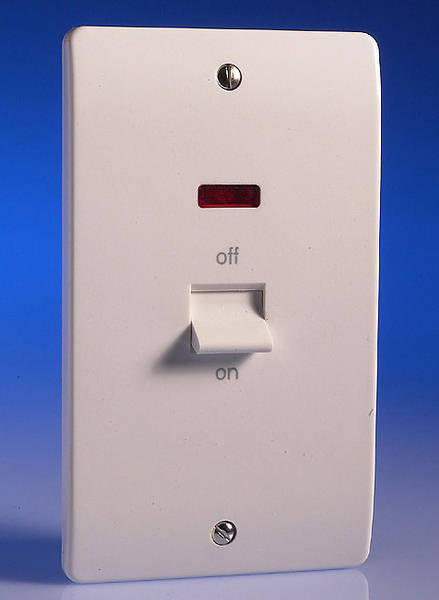Hello,
It's my first post, but I've been reading quite a lot for some time now. I do some diy, have some electric background from college/uni and I'm a computer techy. I can read and understand techy stuff, but I'm no sparky!
My kitchen is getting completely redone, structural work, replastered, rewired, re-floored, re-everything. The "electrician" came today to do 2nd fix. A new consumer unit will be fitted too.
In the position of the built-in dishwasher, he's put a normal recessed single switched socket just behind the appliance on the wall.
I saw an enormous tall socket rated 50A, DP (MK brand) that he said he will fit on the wall, behind the oven. I asked what was the point of a switch if it's behind the oven/behind the kitchen cabinet,he said "you have to have it". I asked "what's the point of a switch if you can't get to it", he said "to hide it, it's very big".
I asked him about fused spurs and accessible switches for each appliance, and he said "it's only required for the oven".
I asked him if the kitchen will be on an RCD: he said "yes".
I asked him if he was registered. He said "yes". I asked if I could have his name and registration number so I can check, and he said he does the work, then his friend comes to certify it (this in principle is fine by me).
I am worried.
1) do built-in appliance require by law, not recommendation, not "should", but "must" have an individual fused supply and an individual accessible switch? (fuse could be in plug, so sounds like only switch is required)
2) this electrical work is part of a bigger job, and if I have to get a new proper electrician to continue the work, it's probably gonna cost me lot more money (pick up someone else's mess) plus the arguing and the resulting bad relation with the building manager, the rest of the works might suffer. Any advice on how to handle this situation smoothly?
Cheers
Thierry
It's my first post, but I've been reading quite a lot for some time now. I do some diy, have some electric background from college/uni and I'm a computer techy. I can read and understand techy stuff, but I'm no sparky!
My kitchen is getting completely redone, structural work, replastered, rewired, re-floored, re-everything. The "electrician" came today to do 2nd fix. A new consumer unit will be fitted too.
In the position of the built-in dishwasher, he's put a normal recessed single switched socket just behind the appliance on the wall.
I saw an enormous tall socket rated 50A, DP (MK brand) that he said he will fit on the wall, behind the oven. I asked what was the point of a switch if it's behind the oven/behind the kitchen cabinet,he said "you have to have it". I asked "what's the point of a switch if you can't get to it", he said "to hide it, it's very big".
I asked him about fused spurs and accessible switches for each appliance, and he said "it's only required for the oven".
I asked him if the kitchen will be on an RCD: he said "yes".
I asked him if he was registered. He said "yes". I asked if I could have his name and registration number so I can check, and he said he does the work, then his friend comes to certify it (this in principle is fine by me).
I am worried.
1) do built-in appliance require by law, not recommendation, not "should", but "must" have an individual fused supply and an individual accessible switch? (fuse could be in plug, so sounds like only switch is required)
2) this electrical work is part of a bigger job, and if I have to get a new proper electrician to continue the work, it's probably gonna cost me lot more money (pick up someone else's mess) plus the arguing and the resulting bad relation with the building manager, the rest of the works might suffer. Any advice on how to handle this situation smoothly?
Cheers
Thierry


